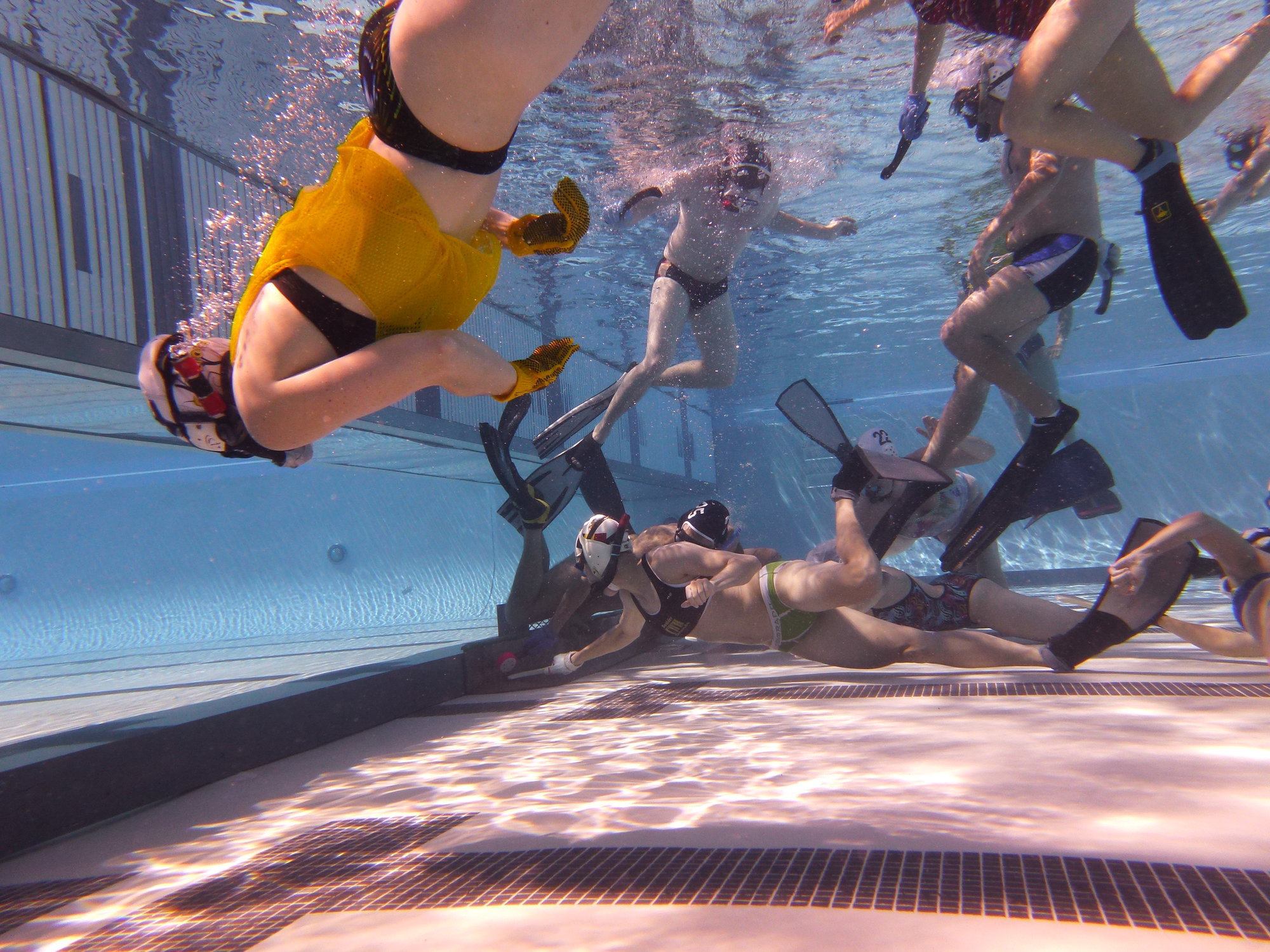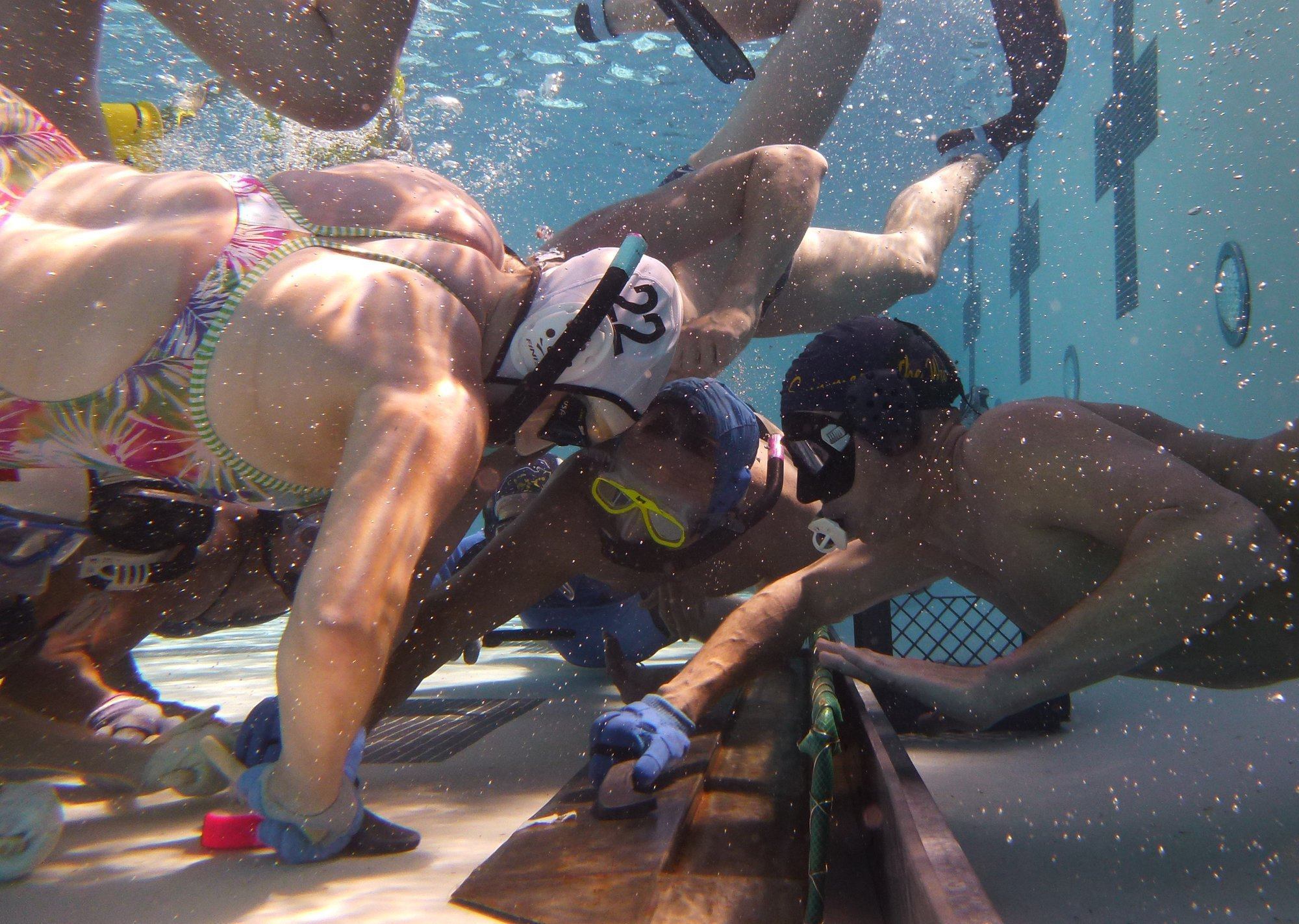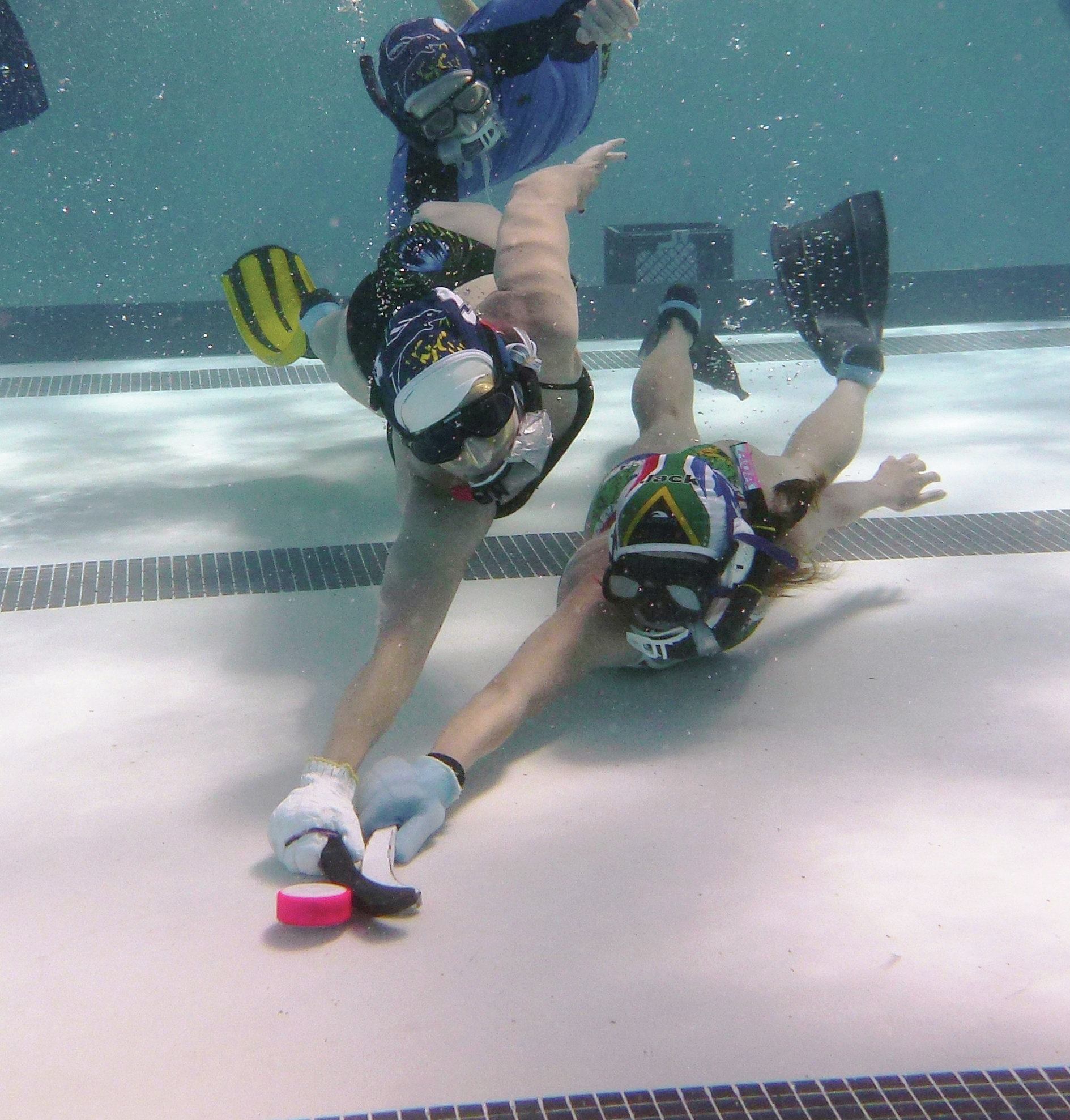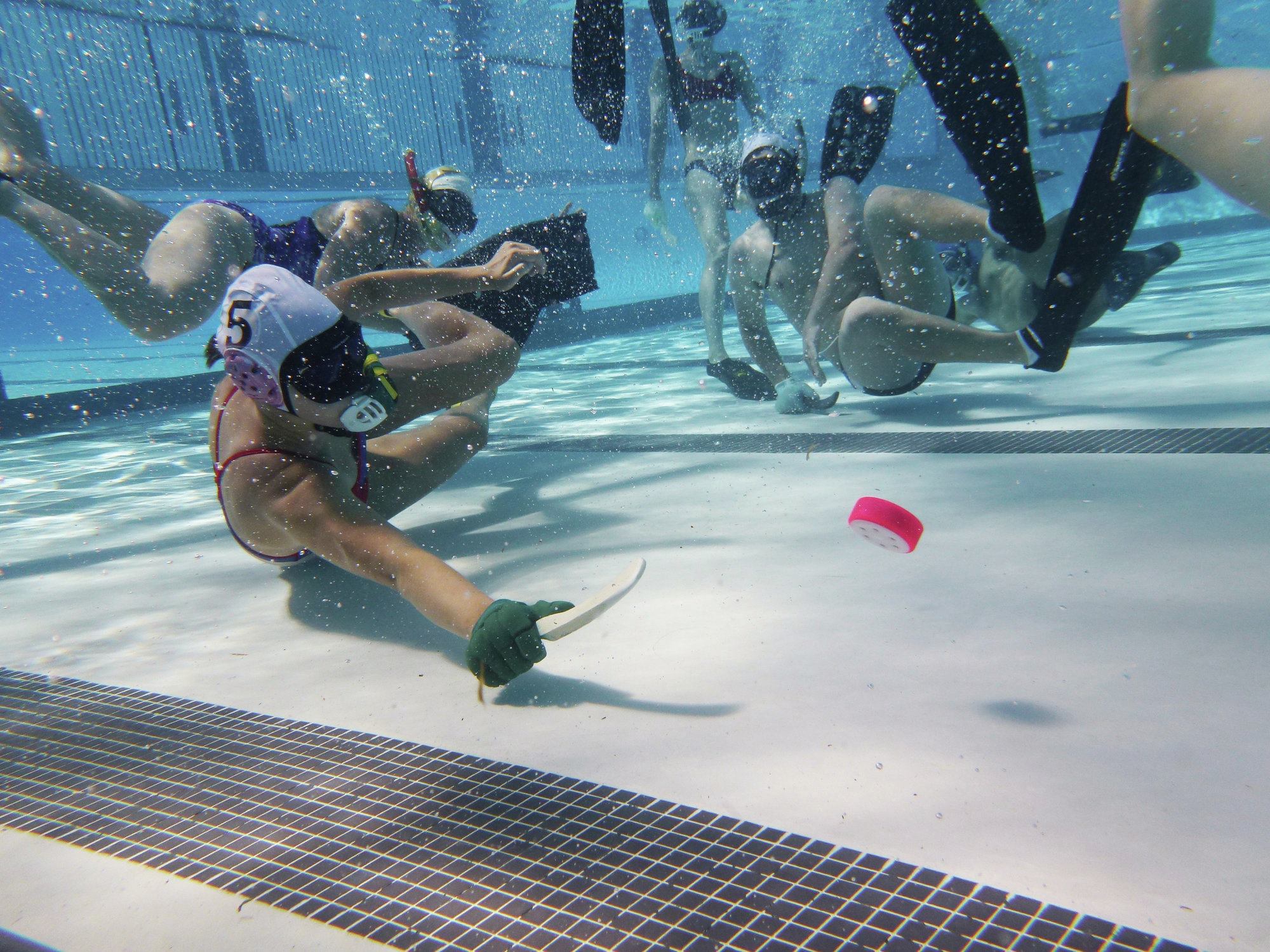If you haven’t already received requests to use your pool for a rather obscure sport called underwater hockey, chances are you will. The game is gaining speed and players are actively searching for venues.
“Underwater what?” may be your initial response. And after hearing how it’s played — just like hockey except players hold their breath to smack a puck across the pool floor — you may heed the alarm ringing in your head and firmly deny the request, saying there are rules against prolonged breath-holding. It’s right there on the sign.
While your reactionary response would be understandable, even commendable, is it justified?
Here, Aquatics International goes below the surface of this emerging international pastime to clear up common misconceptions and to help you determine if this fringe sport is worth adding to your slate of activities.
First, a little background.
Invasion of the puck people
Originally
called octopush, the game pits two teams of eight (hence “octo”) under 6
to 8 feet of water to advance (hence “push”) a puck into the opposing
team’s goal. Each side has six players in the water, with two from each
team waiting poolside to serve as substitutes.
Players need fins for speed, a foot-long stick, goggles, snorkel and a puck, of course. It’s non-contact, but headgear, mouth guard and protective gloves are required.
It started in the United Kingdom in the early 1950s as a way to keep open-water divers occupied during the winter months.
SEE MORE: Senior Editor Gives Underwater Hockey a Shot
The game eventually caught on in South Africa, where players utilized full-size hockey sticks, unlike the Brits who favored shorter shuffleboard-style versions. The U.K. version prevailed; however, the name octopush – thankfully – did not gain global acceptance.
Underwater hockey found a fan in Norm Leibeck, a scuba instructor who introduced the sport to a Canadian dive club in the 1960s. From there, the sport continued spawn fans throughout the world.
The first World Championships were held in 1980 in Vancouver, B.C., formerly recognized and governed by the Confédération Mondiale des Activités Subaquatiques (aka the World Underwater Federation), which oversees a variety of subaquatic competitions, such as finswimming, spear fishing and sport diving, among others.
Subsequent World Championships have been held every two years at locations around the world. Last year’s event attracted 68 teams from 17 countries. That’s more than 900 athletes in four age and gender groups, the largest turnout in the sport’s history. Host city Eger, Hungary, conducted the opening ceremonies with all the pomp and circumstance expected of a prestigious international competition: flag parades, marching bands, opening remarks by city officials, and the like. New Zealand reigned supreme, sending all six of its teams to the finals. Four won.
All this is to say that, yes, it is a sport. It has thousands of passionate players worldwide and they’re adding more to their ranks every year.
Carol Rose likens the sport’s viral spreading to the sci-fi classic “Invasion of the Body Snatchers.”
“Did you ever see that movie? It was a pod that the person carried around that infected people. Well, we carry pucks,” says Rose, president of the Underwater Society of America, which oversees submersed competitive sports.
AI VIDEO:Underwater Hockey Explained
The puck stops here?
Underwater hockey has caught on in Europe, but America has been slow to embrace it.
The aquatics community is understandably nervous about breath-holding activities. Earlier this year, a water polo player from the University of California-Santa Barbara was found unresponsive at the bottom of a swimming pool. A coroner determined that his death was the result of shallow-water blackout, defined as a loss of consciousness caused by prolonged breath-holding, often preceded by hyperventilation while swimming or diving in water 16 feet or less. This silent killer has claimed the lives of several experienced swimmers in recent years.
Michigan State University and the University of Rhode Island both put the kibosh on underwater hockey, citing safety concerns. It took some convincing, but MSU eventually came around and now has its own team. URI, however, remains unconvinced. And players tell of being rejected by municipal pool managers, who fear the game is too risky.
But concerns that underwater hockey presents a hyperventilation hazard are unfounded, advocates say.
“We are not hyperventilating, which is the No. 1 cause for shallow-water blackouts,” says Dr. John “Lucky” Meisenheimer. The dermatologist is not only an avid player, but he also sits on the board of directors of the YMCA Aquatic Center in Orlando, Fla., one of the nation’s pre-eminent facilities, which hosts the sport twice a week.
“If you’re worried about shallow-water blackouts,” Meisenheimer says, “you might as well eliminate water polo, eliminate swimming and eliminate synchronized swimming. The only thing left is diving; I mean, springboard diving! Because every one of those other sports have had shallow-water blackouts.”
Underwater hockey has a good record of safety with no reported drownings and only three heart attacks — all men with known heart conditions, according to Rose.
As she puts it: “It’s kind of hard to drown with 14 people watching. … And it’s not that big of a playing area that you can’t see from corner to corner.”
Not one player, Rose says, has gone unconscious.
Coming up for air
Due
to the rapid nature of the sport, with the puck frequently changing
sides, it doesn’t behoove players to stay below the surface for long.
The strategy is to hover above the field of play, drawing air through a
snorkel, and then dive to the floor to intercept the puck or receive a
pass from a teammate. Once you gain possession, drive the puck toward
the goal. You may score or you may have to pass it off and come up for
air.
Generally, players are under water for 15 to 30 seconds.
Recent changes in the sport’s rules now allow participants to take a break at poolside at any point during the game. They previously could only call in substitutes at halftime or when a point was scored.
“You had these six players playing forever, and let me tell you, they got tired,” says Rose, who’s been drafting and revising rules for the sport since 1976.
The sport’s safety profile and new game play that curbs risk of overexertion has helped smooth the waters, so to speak. The United States currently has more than 50 teams playing at 60 facilities twice a week across the nation.
AI VIDEO:Underwater Hockey Game Footage
Inclusive hockey
If you want to find an even playing field, look under water.
This is one of the few competitive co-ed sports where it wouldn’t be uncommon to find a 16-year-old female competing against a brawny, military-trained man. It’s non-contact making it safe for all to play.
While Meisenheimer might be out-muscled by twenty-somethings on land, the 56-year-old is able to hold his own in the pool. That’s what attracted him to the sport.
“It’s a great feeling for a guy my age to compete at a pretty strong level with young people and feel very good about yourself,” he says.
It’s the kind of program that commercial pools can use to draw a wide variety of participants beyond lap swimmers and parents of swimmers-in-training.
His team has three physicians, two dentists and a business owner. “Those are the people that say, ‘Hey, we understand why the ‘Y’ is here and we have the income to donate back to it,’” Meisenheimer says.
“And we don’t cost the ‘Y’ anything,” he adds. “We’re just a renter at a downtime.”
A sport with staying power
While
a growing number of facilities are willing to let clubs rent space
during off-peak hours, you’d be hard-pressed to find a public pool where
the sport is city-sanctioned — that is, unless you’ve been to Santa
Clarita, Calif.
The Santa Clarita Aquatics Center in suburban Los Angeles has been offering a drop-in program since 2005. Underwater hockey has been going strong ever since, typically attracting 10 to 15 players each week. While many participants are members of L.A. Under Water Hockey, a team that has sent several players to the World Championships, it also attracts the just-plain curious.
“It’s something different to offer. It brings in some revenue, but it’s mainly just another recreational opportunity for people to get involved with,” says aquatics supervisor Lance O’Keefe.
The program now is being offered twice a week, with Thursday sessions mainly geared toward players between 12 and 16 years old.
The facility boasts a 7-foot-deep flat-bottom pool, making it a prime venue to host the national tournament next year.
“This is just one of those non-mainstream sports that have really stuck,” O’Keefe says.
Three quick hits about UWH
The ‘perfect pool’: Ideally, the sport is played across a flat-bottom, tiled floor. Why tile? “It’s the difference between playing air hockey with the table turned on or off,” explains Carolyn Erdman, who plays for the San Francisco Sea Lions. The faster game play on a tile surface requires more finesse, whereas concrete demands more brute strength to advance the puck. But gunite pools can be easily converted. Some facilities have accommodated players by allowing them to drop a plastic interlocking grid court on the bottom of the pool.
World’s worst spectator sport: It’s a given that these games won’t attract onlookers, but some facilities are trying to change that. At last year’s national tournament, which included 28 teams, the University of Minnesota equipped its pool with cameras in each corner and had a scuba photographer follow the big plays. The action was broadcast on a giant screen for all to see.
Olympic glory?: Forgive the expression, but don’t hold your breath. Though it holds more merit than some of the Olympics’ sillier games (racewalking, anyone?) underwater hockey isn’t likely to be included in the near future, says Carol Rose, president of the Underwater Society of America. (Apparently, there are a lot of behind-the-scenes politics involved.) However, players have their goggled sights set on another high-profile event. Birmingham, Ala., put in a bid this summer to host the 2021 World Games (aka the Olympics of non-Olympic sports.) The hosting country does have some pull in deciding which games to include, Rose says. Underwater hockey may have a shot.






